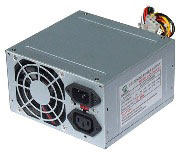What is a Power supply?

A Power supply also known as a power supply unit or PSU, is the component that supplies power to an electronic device such as a computer. All electronic circuits need to be powered from a reliable direct current (DC) source and such power source must be generated from an everlasting source of alternating current (AC) power.
There are a wide variety of power supplies including batteries, fuel cells, electro-mechanical generators, alternating current to direct current supplies, inverters, and alternating current supplies, among many others.
Batteries are a type of electrochemical cell containing a pair of electrodes and an electrolyte disposed between the electrodes. Batteries can be grouped into a primary type and a secondary type. The primary type comprises disposable batteries, and the second type comprises rechargeable batteries. The rechargeable batteries can further be grouped into four types: NiMH (nickel metal hydride), NiCd (nickel-cadmium), Li-Ion (Lithium Ion), and sealed lead acid batteries. Rechargeable batteries have gained wide acceptance and usage as power sources for portable appliances. Mobile phones, digital cameras, camcorders, laptop computers, and personal digital assistants are just a few of the many appliances now using rechargeable battery technology. Battery chargers are often provided as either internal or external devices to be used to recharge these batteries. Generally, the rechargeable battery is charged with a transformer that converts current from a conventional electrical outlet or automobile lighter into a direct current suitable for charging the battery. Rechargeable batteries are provided with a variety of protective functions for preventing damage to the battery caused by abnormal use such as overcharging, over-discharging, and short-circuiting between the positive and negative electrodes. An uninterruptible power supply (UPS) is a type of power supply used to power and protect an electrical load that is sensitive to fluctuations in the absence of electrical power. A UPS typically comprises a rectifier, inverter, and battery charger.
Most personal computers can be plugged into standard electrical outlets. The power supply then pulls the required amount of electricity and converts the AC current to the DC current. It also regulates the voltage to eliminate spikes and surges common in most electrical systems. Not all power supplies, however, do an adequate voltage-regulation job, so a computer is always susceptible to large voltage fluctuations.
